Nor Any Drop to Drink
Effluent for the AffluentIt isn't pollution that's harming the environment. It's the impurities in our air and water that are doing it. - Dan Quayle
Artificial lakes are filled with treated waste water Throughout Phoenix, treated effluent is used to help meet non-drinking water needs. The use of effluent is gaining popularity in central Arizona. This practice decreases the area's dependence on groundwater. Source: Washington Post Photo Voyage 31 October 2001
A Clear Difference
Scott Sargert checks water samples at The Center for the Restoration of Waters This experimental greenhouse is designed to filter 14,000-16,000 gallons of raw sewage a day. Plants, bacteria, snails and fish feed on the sewage and help to purify the water. In this image, Sargert analyses before and after water samples. The purified water is nearly drinkable. Source: wpni01.auroraquanta.com See also:
Where's the Water?Water. If you've got it, you probably take it for granted. But a quick scan of the globe - and a chat with the tiny group of researchers who are obsessed by fresh water - both indicate that water shortages are looming. And they aren't necessarily in the future, either.
You don't miss your water, an old blues sage wisely said, 'til your well runs dry. Down here on planet Earth, the well is starting to run dry. We've seen projections that three billion people - half of today's population - will be short of water in 2025.
As we in water-rich countries take our daily showers, water the lawn or laze about in the pool, it's easy to forget that fresh water is a life-or-death issue in many parts of the world. Of a population of roughly 6.1 billion, more than 1 billion lack access to potable water. The World Health Organization says that at any time, up to half of humanity has one of the six main diseases - diarrhea, schistosomiasis, or trachoma, or infestation with ascaris, guinea worm, or hookworm - associated with poor drinking water and inadequate sanitation. About 5 million people die each year from poor drinking water, poor sanitation, or a dirty home environment - often resulting from water shortage. Parched PlacesOne glance at the map tells you that water is shortest in equatorial countries, often where populations are rising. (Population data below from Population Reference Bureau).
China, with 1.26 billion people, is "the one area worrying most people most of the time," says Marq de Villiers, author of the recently published "Water" (see bibliography). In dry Northern China, he says, "the water table is dropping one meter per year due to overpumping, and the Chinese admit that 300 cities are running short. They are diverting water from agriculture and farmers are going out of business." Some Chinese rivers are so polluted with heavy metals that they can't be used for irrigation, he adds. "They're disgraceful, unusable, industrial sewers." As farmers go out of business, China will have to import more food. In India, home to 1.002 billion people, key aquifers are being overpumped, and the soil is growing saltier through contamination with irrigation water. Irrigation was a key to increasing food production in India during the green revolution, and as the population surges toward a projected 1.363 billion in 2025, its crops will continue to depend on clean water and clean soil. Israel (population 6.2 million), invented many water-conserving technologies, but water withdrawals still exceed resupply. Overpumping of aquifers along the coast is allowing seawater to pollute drinking water. Like neighboring Jordan, Israel is largely dependent on the Jordan River for fresh water.
Water FightEgypt, whose population of 68 million may reach 97 million by 2025, gets essentially no rainfall. All agriculture is irrigated by seasonal floods from the Nile River, and from water stored behind the Aswan High Dam. Any interference with water flow by Sudan or Ethiopia could starve Egypt.
"The Nile is one I worry about," says Sandra Postel, director of the Global Water Policy Project. Egypt, she says, is militarily powerful but vulnerable. "The hydropolitics might favor some military action, because Egypt is so heavily dependent on the Nile, it's already virtually tapping out the supply, and Ethiopia is now getting interested in developing the headwaters." When a World Bank official suggested several years ago that water wars are not far off, he might have had Egypt on his mind - or Turkey, Syria and Iraq, another trio of Middle-Eastern states that are locked in an uncomfortable embrace over water. The Tigris and Euphrates Rivers both rise in Turkey and flow unimpeded to Syria and Iraq, where they provide the bulk of irrigation water needed in the arid climate. Turkey has proposed a series of dams that would reduce river flow. That causes alarm downstream.
A Working RiverInternational water politics play a role in the Southwestern United States, where the Colorado River is shared by many states before its dregs trickle into Mexico. All along the river, water is diverted for irrigation and urban water - with Arizona and California the biggest users. Because Mexico uses the dribble of water that reaches it for irrigation, virtually nothing reaches the river's once-fertile - and now parched and polluted - delta on the Sea of Cortez. The Colorado may be completely allocated, but the Southwest continues booming. According to one estimate, five of the 10 fastest-growing US states are in the river's drainage. The water the newcomers drink is likely to come from farmers who now receive subsidised river water. The rivers we've mentioned are some of the 200 and 300 major lakes and rivers that transcend national boundaries. The list includes such major items as the Nile, the Amur River between Russia and parched northern China, the Niger in Africa, and the Mekong, Indus and Ganges in Asia. Not Dry as DustDespite the potential for fights over water, shortages can increase cooperation as well as friction. Jordan and Israel closely cooperate on the preservation of the Jordan River. Author de Villiers says water shortages, rather than exacerbating tensions in the Middle East, "have brought them together" - although we wouldn't overstate the degree of cooperation. Egypt stores a great amount of Nile water behind the Aswan High Dam, but the high rate of evaporation in the desert is an incentive to transfer the storage upstream, where, according to Postel, it would evaporate 1/3 as fast. Although that would leave more water to be shared, Egypt would never allow Ethiopia to build dams without assurances of a steady water supply in drought years. Although there's no agreement yet, there's been some cooperation, Postel says. "Ethiopia and Egypt meet about water every year, trying to work toward a watersharing arrangement - something they would not have considered 10 years ago." There are other reasons for optimism about the generally dismal water situation. For example, total US usage has dropped 20% from a peak in 1980. De Villiers says some underdeveloped countries are likewise reducing consumption. "Namibia is famously thrifty for its use of water [in dry years, up to 30% of the capital's drinking water is recycled wastewater]. Egypt recycles virtually everything they get." And while rivers are heavily polluted in China and elsewhere, a few rivers are being restored. De Villiers says the Rhine, once called the sewer of Europe, has been cleaned up over the past decade or so. "I'd not want to drink it, but fish are reappearing in the river." Who's Gonna Pay the Pumper?You might think that since fresh water is more valuable than diamonds, there'd be no need to price it. You'd be wrong. "Free" or subsidised water is bound to be wasted, according to most experts. Why bother fixing the leaky faucet if that would cost more than you'd save? Why buy better irrigation technology if it won't save you money? No reason. And that's why we hear so many suggestions that water users must pay the price. Easier said than done, in many cases. Sandra Postel, who has studied water policy for many years, observes, "Most water in developing countries, especially in agriculture, is not metered, and you can't charge for volume unless you have a way to measure it." She suggests that rationing or better technology could encourage more efficient use where water cannot be metered. The subsidies are "most dramatic in irrigation," which accounts for about 70% of worldwide use, says Postel. "In most cases, farmers pay 10-15% of the real cost, or get it free." And because water subsidies usually go only to rich farmers, Postel says they are "not necessarily helpful from a conservation or equity standpoint." Water subsidies are a fact of life in the western United States. According to de Villiers, they amount to $500 per acre. He alleges that "70% of the farmers' profits in California's Central Valley - which is supposed to be the richest farmland in the world - came directly through taxpayer subsidisation." Charging for water has dramatic effects, de Villiers adds, causing usage to decline by about 30%. However, as water becomes more expensive, farmers may go out of business or plant more profitable crops. That can reduce a country's ability to feed itself. Privatisation: Peril or Panacea?In cities, water often arrives in a truck, especially on the outskirts of megacities like Jakarta, Bangkok and Mexico City, where water pipes are absent. Vendors may charge "exorbitant prices for dubious-quality water," says Postel. "Because ...society has not provided water, many are spending 1/4 of their income on water. It's a tremendous inequity caused by the failure to provide for basic needs." The World Bank and other international development agencies have spent a lot of money on water supplies, purification systems, wastewater plants and dams. Money is always short, but even well-funded water projects can fail without good management. In a 1998 interview, John Briscoe, then the World Bank's senior water advisor said, "Right now, there's a huge amount being spent for terrible service." Many urban water utilities, Briscoe added, "Are run as government departments with no interest in serving users, but only maintaining employment and serving government ministers. They are some of the worst-run public agencies you can find." One solution, he says, is to put water utilities on a profit-making basis. And while privatisation has its critics, it beats not getting water. "The evidence is absolutely clear in my mind," says Briscoe. "For poor people in particular, the worst thing is to be denied access. They are happy to pay a reasonable cost, but not if it's going into the pocket of politicians." Charging higher prices for piped water may bite the poorest less than expected, says de Villiers, since in many countries, "The only people who have running water are the rich." The poor, he notes, may already be paying high prices to itinerant water sellers. Water fees, he says, pump money into the water infrastructure so water pipes can be laid, and they focus attention on the diminishing resource called fresh water. Yet water-for-profit is no panacea. Privatisation failed in Bolivia's third-largest city, Cochabamba. High prices forced some inhabitants to choose between food and water, and the government cancelled the contract with the private utility. In terms of household usage, Postel says, "This is not a problem of scarcity, it's problem of political will. The means are there to provide everybody with basic needs, 50 liters per person per day. It's not had a high enough political priority." Poor people who lack access to clean water, "get water from unclean surface ponds or dirty rivers, and they get sick and die." Can Technology Help?Because water is generally used so inefficiently, Postel calls conservation "the last oasis." Simple devices like low-flow toilets can cut usage by 70%. When New York City was faced with spending $1 billion on a new pumping station in the early 1990s, it opted instead to replace toilets. By 1997, after the city spent $295 million on incentives, 1.33 million new toilets had been installed, saving 70 million to 90 million gallons per day. Overall, per capita consumption dropped from 195 gallons in 1991 to 169 gallons in 1999.
Agriculture, which uses about 70% of total fresh water, offers much larger savings. Drip irrigation, pioneered by Israel, delivers water directly to the crops roots. Although it's more expensive to start with, it's far more frugal as well in terms of water. And delivering water steadily to the roots improves production as well. Postel writes, "Studies in India, Israel, Jordan, Spain and the US have shown time and again that drip irrigation reduces water use by 30 to 70% and increases crop yield by 20 to 90% compared with flooding methods." FloodingReuse of wastewater is becoming a fact of life in many arid regions, including Egypt, Israel, and the American Southwest. Depending on its cleanliness, water may be used to irrigate non-food crops, or even food crops. In the extreme example, Namibia drinks treated wastewater in drought years. Desalination - the removal of salt from salt water - would be the ultimate solution to water woes - if it can be done cheaply enough. That's a big if: "The best estimates are $2 to $2.50 per ton for desalination," says de Villiers. "That not really that far from the real cost of delivering water from the Colorado River, but California's water is so heavily subsidised that they are paying 10¢ per ton when the real cost is closer to $2.50 per ton." Desalination also takes a lot of electricity, de Villiers notes. "Unless somebody comes up with a way to do it with less energy," the cost of more fresh water could be increased global warming. Hydrology of a Hothouse WorldWhat will global warming do to the supply of fresh water? As the ocean warms, sea level will rise. We'll see more evaporation and precipitation, and more storms. While the local effects of global warming cannot be predicted, "You can't not look at it," says Sandra Postel. Warming "will literally change the hydrology of every major river basin in the world, especially in Asia." While regional rainfall is hard to predict, increases in temperature will affect the snow supply that feeds major rivers. "Most major rivers in Asia come from the mountains," Postel notes. "The Ganges, Indus, and Yellow are dependent on mountain snowpack for their flow." Snowpack, she says, is "beautiful from a water point of view" because the snow is a natural reservoir that melts in spring and summer, just when water is needed in downstream areas. As temperatures warm, she says, more precipitation will fall as rain, and the snow will melt sooner, so peak runoff will occur earlier in the year. The change, Postel says, "will worsen the water situation in places where they are already scrambling." She cautions that the Ganges, Indus and Yellow are already "tapped out in the dry season." The same problem could affect rivers fed by the Andes, Rockies, and Alps. Craving Carbon?Some skeptics have noted that global warming could have a fringe benefit - more carbon dioxide seems to hasten plant growth, but that can't happen without water, or if the land gets too saline. Overall, the problem is an unending demand, caused by soaring population and industrialisation, splashing up against a finite supply. The water crisis is "definitely getting worse," says Postel. "The basic issue is the fact that water is renewable but finite, any place where the population grows, you'll have a diminished supply per person." Rather than continually looking for another river to dam, Postel suggests working more intelligently with the existing supply. "We need a fundamental shift to meeting basic human needs and improving efficiency rather than continuing to find new sources. That's a no-win proposition. Every additional unit we take out of the natural environment causes environmental degradation. We need to do more with less through a focus on policy and institutions." Source: whyfiles.org 26 April 2001 © University of Wisconsin, Board of Regents; aerial quilt photo courtesy Mitchel Resnick and Brian Silverman; Alamo dry streambed photo courtesy Mark Finco.
BibliographyPaper
Electronic
CreditsInterview Subjects:
See also:
Climate Shift Helped Destroy China's Tang Dynasty: ScientistsThe Tang dynasty, seen by many historians as a glittering peak in China's history, was brought to its knees by shifts in the monsoon cycle, according to a study. Famed for a flowering of art and literature and for prosperity brought by trade with India and the Middle East, the dynasty spanned nearly three centuries, from AD 618 to 907, before it was overwhelmed by revolt. Scientists led by Gerald Haug of the Geoforschungszentrum (GFZ) in Potsdam, eastern Germany, looked at sedimentary cores taken from a lake at Zhanjiang in coastal southeastern China, opposite the tropical island of Hainan. The magnetic properties and content of titanium in these deposits are an indicator of the strength of the winter cycle in the East Asian monsoon system, they believe. They found that over the past 15,000 years, there had been three periods in which the winter monsoon was strong but the summer monsoon was weak. The first two periods occurred at key moments during the last Ice Age, while the last ran from around 700 to 900. Each of these monsoon shifts coincided with what was, relative to the climate epoch, unusually cold weather. The twilight of the Tang began in 751, when the imperial army was defeated by Arabs. But what eventually destroyed the dynasty were prolonged droughts and poor summer rains, which caused crop failure and stoked peasants' uprisings. Eventually, these rebellions led to the collapse of the dynasty in 907. Haug's team suggests this shift in tropical precipitation occurred on both sides of the Pacific, not just in coastal East Asia. The same migration of the rainband occurred in Central America and doomed the so-called classic period of the Mayan civilisation, at almost exactly the same time as the Tang era, they believe. Comparison of the titanium records from the Huguangyan Lake, in Guangdong province, and from the Cariaco basin, in Venezuela, have thrown up striking similarities. Both suggest a general shift towards a drier climate at around 750 and then, during these generally drier period, 3-year cycles in which rainfall was very low. The new study appears in Nature, the weekly British science journal. Source: www.breitbart.com 3 January 2007
For pages on several types of disasters - including lightning strikes, volcanoes, floods, hurricanes, tornados, global warming and more - and also some great satellite photos and
pictures of castles and beautiful trees, clicking the "Up" button immediately below takes you to the Table of Contents page for this Environment section. |
 Animals
Animals Animation
Animation Art of Playing Cards
Art of Playing Cards Drugs
Drugs Education
Education Environment
Environment Flying
Flying History
History Humour
Humour Immigration
Immigration Info/Tech
Info/Tech Intellectual/Entertaining
Intellectual/Entertaining Lifestyles
Lifestyles Men
Men Money/Politics/Law
Money/Politics/Law New Jersey
New Jersey Odds and Oddities
Odds and Oddities Older & Under
Older & Under Photography
Photography Prisons
Prisons Relationships
Relationships Science
Science Social/Cultural
Social/Cultural Terrorism
Terrorism Wellington
Wellington Working
Working Zero Return Investment
Zero Return Investment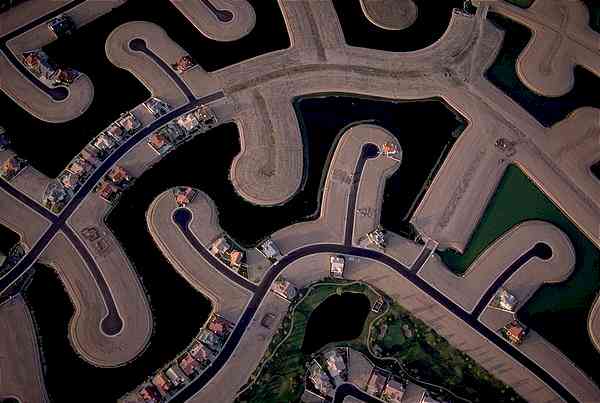
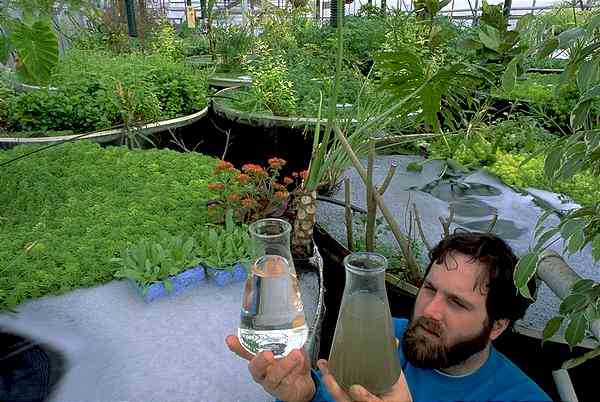
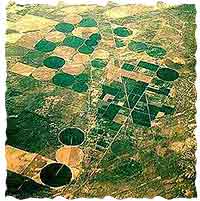 A center-pivot irrigator has a long horizontal pipe. The inner end pivots, and the outer
end is on wheels. As the irrigator pivots, it creates a circular field.
A center-pivot irrigator has a long horizontal pipe. The inner end pivots, and the outer
end is on wheels. As the irrigator pivots, it creates a circular field.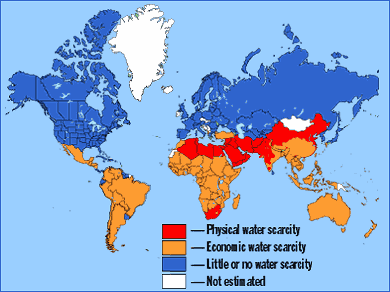
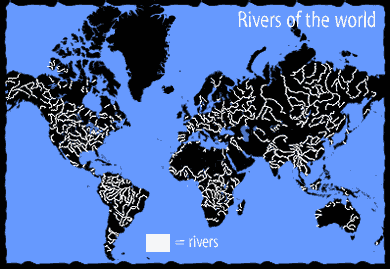
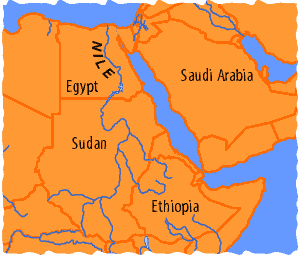
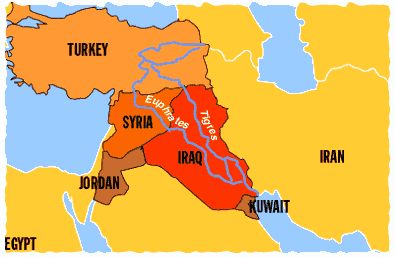
 As it crosses the US-Mexico border, the Alamo River is mainly a memory. Water withrawals
further north for irrigation help diminish the stream here to a green patch on the landscape.
As it crosses the US-Mexico border, the Alamo River is mainly a memory. Water withrawals
further north for irrigation help diminish the stream here to a green patch on the landscape.